July 8, 2022 —
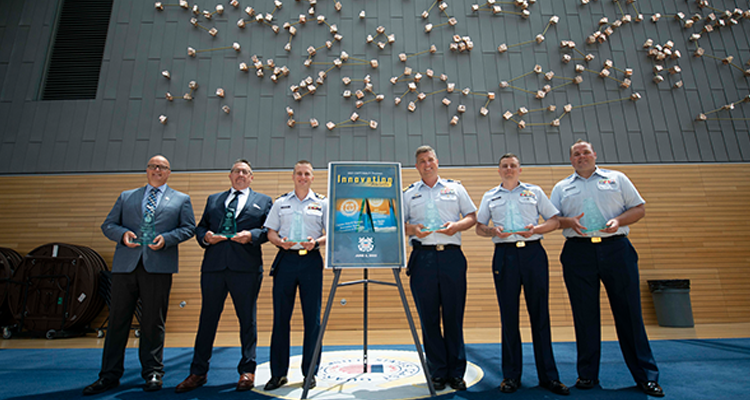
Recognized with Innovation Awards for 2021 are, from left: Carl Boehmer accepting for the Breaking Barriers and Connecting Coasties through Mentoring team, who won for the Mentorship Program Leveraging Artificial Intelligence in the Culture Change category; Brad Schoenwald accepting for the team who won the Cmdr. Joel Magnussen Innovation Award for Management for the Cruise Ship Scorecard Prevention Measurement Tool; Lt. Cmdr. Donald Rudnickas, who won for Multispectral Automated Iceberg Detection in the Science or Technology category; Cmdr. Chad Brick, who won for the Family Assessment Support Tool in the Administration, Training or Support category; and two separate winners in the Operations or Readiness category: Chief Petty Officer Thomas J. Roposa, who won for 47-foot Motor Lifeboat Lighting Improvements, and Senior Chief Petty Officer Jason Bryant, who won for Text-to-SMS for Command Centers. Not pictured is Auxiliarist Clint O’Connor, who won for Aid Verifier Assistant App for Navigation Reports in the Auxiliary Achievement category. U.S. Coast Guard photo by Petty Officer 2nd Class Ronald Hodges.
The Coast Guard recognized trailblazers in its workforce with Capt. Niels P. Thomsen Innovation Awards June 2 during the Senior Leadership Conference held at Coast Guard Headquarters.
“The service is better because of the ideas you have,” Adm. Linda Fagan, Coast Guard commandant, told the winners during the ceremony. She thanked them for their courage and creativity, “all done in addition to your regular duties.”
Fagan’s Commandant’s Intent touches on innovation in multiple ways, including driving a culture of innovation to sharpen the Coast Guard’s competitive edge and using assets, people and capabilities in new ways to advance mission excellence. She charged Coast Guard senior leadership with making innovation part of their individual commander’s vision, reminding them “we set the tone.”
“The way that the world is changing is evolving, and the pace of that change is accelerating,” Fagan said. “It is critical that we keep pace with that change.”
The Coast Guard Innovation Program is part of the Office of Research, Development, Test & Evaluation (RDT&E) and Innovation and falls under the Acquisition Directorate. Rear Adm. Douglas Schofield, assistant commandant for acquisition and chief acquisition officer, told the gathering, “I certainly believe that every Coastie is an innovator…. You’re bringing great capability to our operators and sharpening our competitive edge.”
The annual awards recognize innovative efforts by the Coast Guard workforce to increase efficiency or productivity or provide other process improvements. Their namesake developed a chain stopper in 2008 credited with dramatically improving the safety of buoy tending operations for the Coast Guard. Forty-four initiatives were nominated for the 2021 awards.
This year’s winners:
Science or Technology
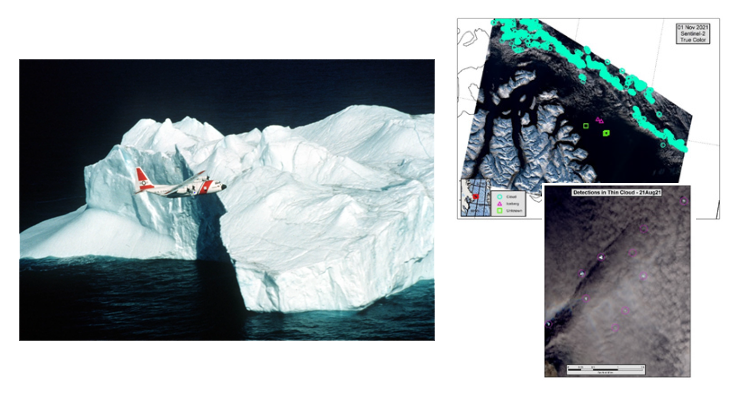
The algorithm used in Multispectral Automated Iceberg Detection allows the Coast Guard to harness satellite images for iceberg reconnaissance. Left: A Coast Guard HC-130J long range surveillance aircraft overflies an iceberg during patrol with the International Ice Patrol. U.S. Coast Guard photo (DVIDS). Right: Sample output from the Sentinel-2 Iceberg Detection Script utilized by the International Ice Patrol to automatically locate icebergs in multispectral satellite imagery. The top image shows icebergs (pink triangles) successfully detected by spectral reflectance from among other target types (i.e. cloud) along the coast of Baffin Island, Canada, in November 2021. The bottom image provides examples of icebergs (circled in magenta) detected by spectral reflectance through thin cloud in Disko Bay, Greenland, in August 2021. Imagery from Copernicus Sentinel data 2021.
Multispectral Automated Iceberg Detection: Lt. Cmdr. Donald Rudnickas.
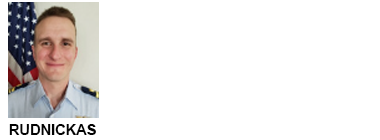
Rudnickas, who serves as deputy commander of the International Ice Patrol, created an algorithm that automates detection of icebergs in visible and infrared satellite imagery, providing an additional iceberg detection and classification asset at no cost to the Coast Guard. His efforts have accelerated the transition to satellite-only iceberg reconnaissance, resulting in an annual savings of around 500 hours of HC-130J patrols and ultimately benefiting the maritime community with accurate and timely iceberg warnings.
Rudnickas explained that using satellite imagery to detect icebergs is “like looking for a needle in a haystack … the computer is going pixel by pixel or piece of hay by piece of hay,” which takes a lot of time and leaves plenty of room for error. Multispectral images allow the detection of energy given off by icebergs, distinguishing them from their surroundings. To complete the haystack analogy, Rudnickas said the process is like adding a metal detector to the search for the needle.
Operations or Readiness
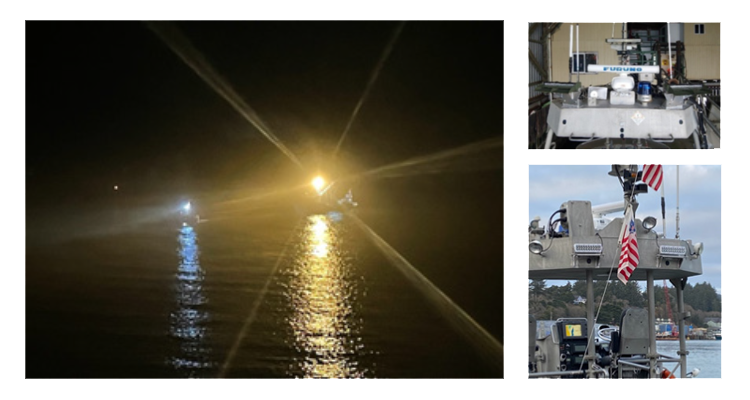
Specially designed lighting improvements upgraded safety and visibility while operating a 47-foot motor lifeboat (MLB). Left: An MLB towing a disabled fishing boat through Yaquina Bay Bar. Right: The new LED forward lighting system (top) and stern light system (bottom) installed on the 47-foot motor lifeboat. U.S. Coast Guard photos (Station Yaquina Bay).
47-foot Motor Lifeboat Lighting Improvements: Chief Petty Officer Thomas J. Roposa.
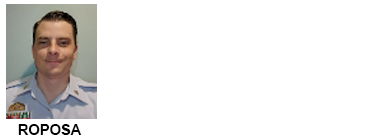
Roposa dedicated extensive off-duty time while assigned to Station Yaquina Bay, Oregon, to research, design and prototype a new LED lighting system to improve safety and visibility while operating a motor lifeboat (MLB) at night and in hazardous maritime conditions. After selecting better, more cost-effective lights, he completed numerous tests and design iterations – looking at various mounting positions and adding lighting shields he fabricated using computer-aided design software and his own equipment. Extensive operational testing on the newly outfitted MLB proved a remarkable increase in coxswain visibility because of these improvements, which are now being implemented on all 107 Coast Guard 47-foot MLBs as part of their Service Life Extension Program.
Roposa said there had been other efforts to improve lighting on the MLB, but attributed his success to his familiarity with the boats and the hazardous conditions in the area, as well as an aptitude for tinkering. “These improvements mitigate some risk to the crews onboard and aid in finding mariners in distress. If it helps save one life, it was worth the effort.”
Operations or Readiness
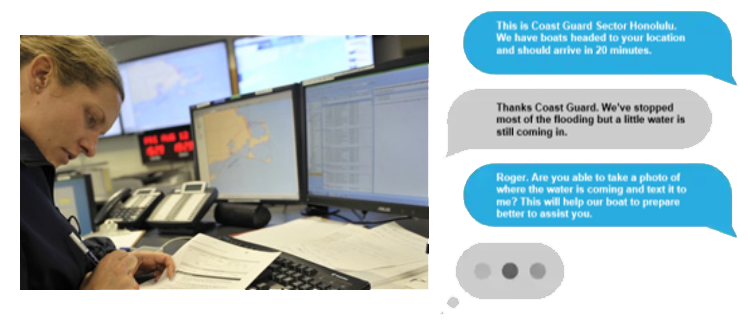
Text-to-SMS for Command Centers seeks a way for two-way communication with members of the public who might not have radios or are in areas with spotty or no cell service. Left: An operations specialist completes paperwork following a search and rescue case based on a call to Coast Guard Sector Southeastern’s command center. U.S. Coast Guard photo (DVIDS). Right: A sample text a mariner will receive during operation. U.S. Coast Guard photo (Sector Honolulu).
Text-to-SMS for Command Centers: Senior Chief Petty Officer Jason Bryant.
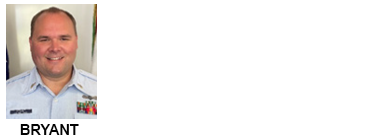
Currently the Coast Guard has no enterprise or best practice stand-alone capability to communicate with mariners via Short Message Service/Multimedia Messaging Service (SMS/MMS) text from Coast Guard workstations within the service’s command centers. Bryant, who is sector command center supervisor for Sector Honolulu, wanted to improve rapid and efficient communication between Coast Guard command centers and the general public.
“Many people don’t have radios even though they should have, and in many areas cell phone reception isn’t available or is spotty, but people can text,” Bryant said. Texting is “what the public expects these days.” He noted that watch standers sometimes use their personal cell phones to send texts if they cannot reach the person through other means because, “at the end of the day, we’re doing whatever we can to protect lives.” However, that approach can cause issues when the public then associates that cell number with the Coast Guard and uses it for future communications, including times when an individual watch stander is off duty or even after they transfer to a new unit.
Sector Honolulu was awarded seed funding to identify and pilot test potential software as service solutions in collaboration with the RDT&E and Innovation program. During pilot testing, Bryant’s team found that the ability for command centers to communicate directly with mariners via SMS/MMS measurably enhances the timeliness and effectiveness of Coast Guard response. After demonstrating the benefits of the approach, the effort has been expanded to add a second phase; Bryant is currently working with command centers across the Coast Guard to validate requirements and identify a sustainable platform with third-party vendors.
Administration, Training or Support
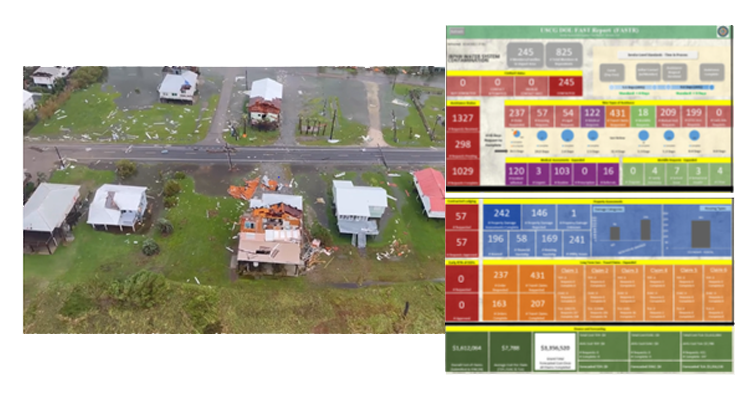
The Family Assessment Support Tool (FAST) empowers Coast Guard support teams to systematically contact service families directly to understand their needs, de-escalate anxiety and connect them to specialized services. Left: The view as the Coast Guard conducts overflights along the Gulf Coast following Hurricane Ida. U.S. Coast Guard photo (DVIDS). Right: A FAST Report sample that enables the Coast Guard to take a proactive approach during contingency operations by providing individualized crisis management and personalized care directly to service members. Imagery from Rear Adm. Jon Hickey, Director of Operational Logistics, and Cmdr. Chad Brick, Base Galveston.
Family Assessment Support Tool: Cmdr. Chad Brick.
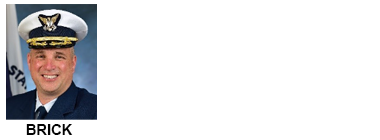
Brick created the Family Assessment Support Tool (FAST) to enable the District 8 (D8) Incident Command to identify, respond and track the status of all Coast Guard personnel and family members impacted by Hurricane Ida. Because of its success, FAST has been expanded to support all hazards/contingencies. Broadly, FAST allows watch commanders to quickly engage with Coast Guard families following a contingency, triaging needs and connecting personnel with the right mission support service providers to tackle whatever hardship they are facing. Following Hurricane Ida, FAST enabled D8 and the Director of Operational Logistics to respond to and process over 1,600 evacuation orders/claims and over 1,370 housing damage assessments. FAST also enabled provision of temporary lodging for over 200 members and families, legal assistance for over 300 members, financial assistance for over 650 members and medical assistance for over 30 members.
FAST allows us to “push service versus pull service,” Brick said. “Rather than waiting for someone to contact us about a problem, we reach out with an overall care call,” providing individualized crisis management and personalized care directly to Coast Guard members and their families. A side benefit of the system is peace of mind for Coast Guard personnel. “With FAST, you can get underway on your mission and know your family will be taken care of,” he added.
The FAST Report enables commands to personally contact each family to learn their needs, then prioritizes and connects those members directly to specialized services and the right support personnel to provide follow-on care and continuity of service until all issues are addressed. This report expedites the processing of entitlements (i.e. funds get to families faster) and empowers Coast Guard service providers to triage needs and successfully tackle even the most difficult hardships including work-life issues, legal services, temporary lodging, property damage assessments, evacuation orders, travel claims, mutual assistance and medical care.
Culture Change
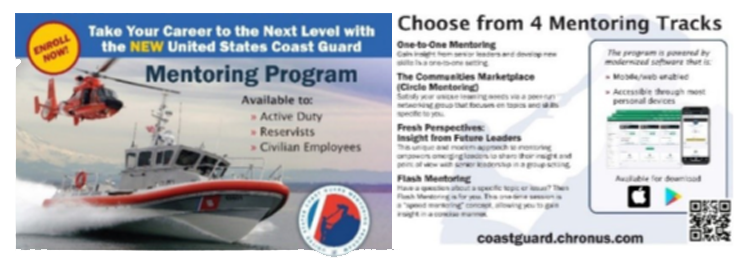
A flyer advertising the new mentorship program leveraging artificial intelligence and describing four mentoring tracks. Imagery from Coast Guard Mentoring Program (CG-128).
Mentorship Program Leveraging Artificial Intelligence: Breaking Barriers and Connecting Coasties through Mentoring team headed by Carl Boehmer, Capt. Julie Kuck, Chief Petty Officer Angel Limongelli and Petty Officer 1st Class Tyler Mleczko.
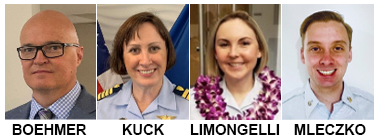
The new Coast Guard Mentoring Program uses app-enabled software that leverages artificial intelligence (AI) and matching algorithms to connect the service’s geographically dispersed workforce. It offers four formats and is available 24/7. Unlike Facebook communities that appear to offer similar networking opportunities, this program adheres to Coast Guard cybersecurity protocols and prevents any risk to the Coast Guard. Program enrollment is currently around 2,500, including around 1,500 mentors.
“All of the previous mentoring programs depended on a human matching people on a spreadsheet … and involved a certain time frame,” Boehmer said. AI and the matching algorithms provide options to allow for the best possible connections. The program was careful to include a human element, however. “You answer questions that reflect your personality, comfort level and goals…. Once you see your matches, the system provides filters to narrow down the choices so you can pick who you will feel most comfortable talking to.” The program also can be used as a networking platform, Boehmer said. “You can connect through things like similar goals, where you attended college, where your next duty station will be. It can be short term, long term, even a one-time meeting.”
Auxiliary Achievement
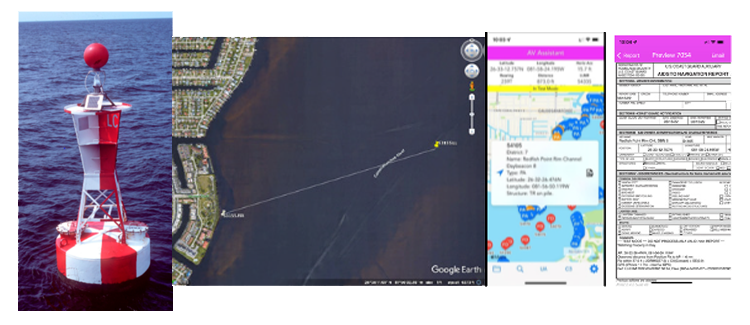
The Aid Verifier Assistant (AVA) app automates the process of confirming that aids to navigation are in the correct location or need to be relocated. Left: A buoy on station in Pennsylvania. U.S. Coast Guard photo (DVIDS). Middle: A screenshot of Google Earth, generated by the AVA app, showing an aid that was in the correct physical location but its assigned position in the Light List was in the middle of a river. Right: A sample verification report from the AVA app, showing the Light List detail in the left image and the generated 7054 report in the right image.
Aid Verifier Assistant App for Navigation Reports: Auxiliarist Clint O’Connor.
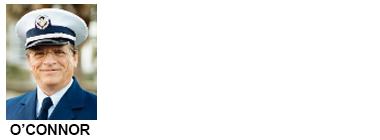
O’Connor developed an Aid Verifier Assistant (AVA), which is a mobile app that enables Auxiliarists and qualified aid verifiers to report verifications and discrepancies quickly and accurately to the Coast Guard using the standard 7054 PDF form. AVA does not require a cell phone connection and can generate reports in real time. The app can provide Light List and Local Notices to Mariners information on any surrounding aid and enable an aids verifier to create the required verification report, complete with a position fix and annotated photos. This app is currently under evaluation in the Coast Guard’s RDT&E Fiscal Year 2022 Project Portfolio.
“Verifying private aids to navigation is an essential part of waterways management,” said Auxiliarist Vincent Pica, who was involved with the project. The Coast Guard leverages the Auxiliary’s capabilities to access areas that are more difficult for Coast Guard vessels to get to but are used regularly by recreational boaters. O’Connor added later that “this app takes more than 90 percent of the effort out of reporting a 7054 verification or discrepancy, and eliminates many sources of human and manual error as well.” He noted, “I’d rather spend more time writing a tool to avoid unnecessary paperwork than I would have doing the paperwork.”
Cmdr. Joel Magnussen Innovation Award for Management
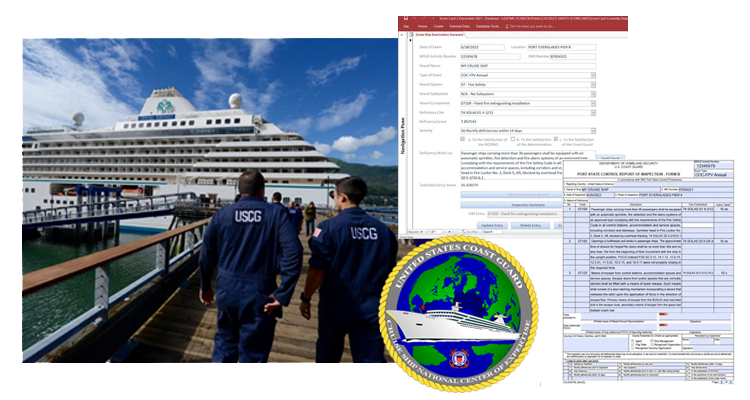
The Cruise Ship Scorecard measures inspection team performance and provides a human performance incentive with better deficiency data that can be understood and analyzed. Left: Members of Coast Guard Sector Juneau inspections division arrive to conduct a certificate of compliance exam. U.S Coast Guard photo (DVIDS). Right: The top image shows the Access Database Scorecard input page. Each deficiency site auto-populates the corresponding Safety of Life at Sea regulation verbiage. The bottom image shows form B, which is auto-generated and ranks all the recorded deficiencies in order of severity. Imagery from Cruise Ship National Center of Expertise.
Cruise Ship Scorecard Prevention Measurement Tool: Cmdr. Jason Kling, Brad Schoenwald, Christine Mahoney, Sam Cheung, Lt. Cmdr. Thomas Gibson, Lt. Cmdr. Theresa Bigay, Daniel Brehm, Scott Elphison, James Garzon, Eric Jesionowski and Lt. Kimberly Glore.
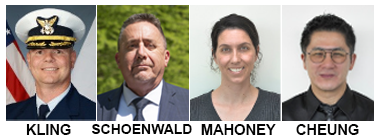
The Coast Guard Cruise Ship National Center of Expertise (CSNCOE) with the Coast Guard Research and Development Center developed the Cruise Ship Scorecard application to better evaluate the degree of noncompliance found by Coast Guard examiners during cruise ship inspections. Deficiencies are weighted based on a predetermined priority scale, and the score also shows the amount of risk that will be mitigated with the resolution of the identified issues. The CSNCOE provided each field unit conducting cruise ship exams with a tablet computer preloaded with the scorecard application. The tool improves the inspection process and reduces the time Coast Guard inspectors spend on board the vessel. It also streamlines and automates findings to produce a standardized report of inspection and scores the exam team to measure the value of their findings.
“We used to just have an aggregate of the deficiencies found during the inspection,” said Schoenwald, a senior marine inspector and lead instructor at CSNCOE and the scorecard’s originator. “Now each deficiency is weight-rated, so we get a better picture at the seriousness of the noncompliance based on safety.” The metrics have an additional purpose: “Prevention is difficult to measure,” Schoenwald said. “Through a measurable performance metric, we can identify a quantifiable outcome and really gauge and analyze our efforts in the prevention of marine incidents aboard ships.”
Related:
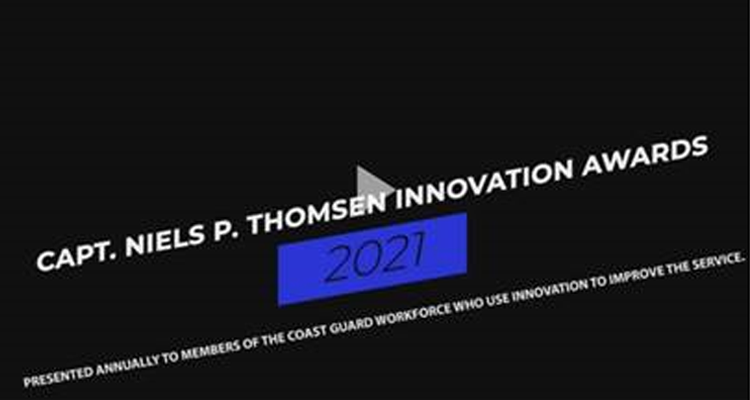
Video: Capt. Niels P. Thomsen Innovation Awards 2021
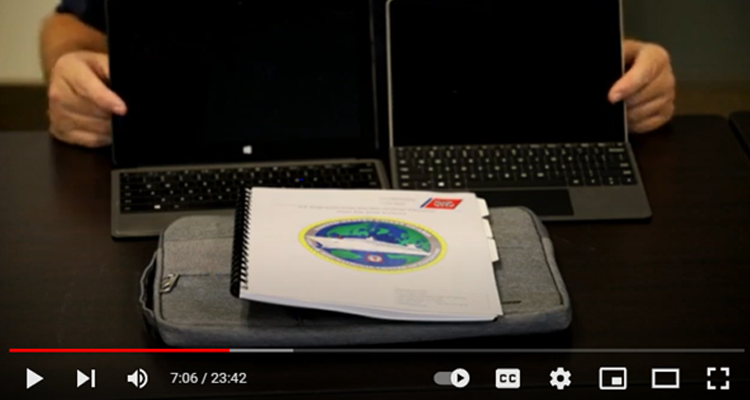
Video: U.S. Coast Guard Cruise Ship Scorecard
For more information on Coast Guard innovation: Innovation Program page
For more information on Coast Guard RDT&E: Research, Development, Test & Evaluation Program page